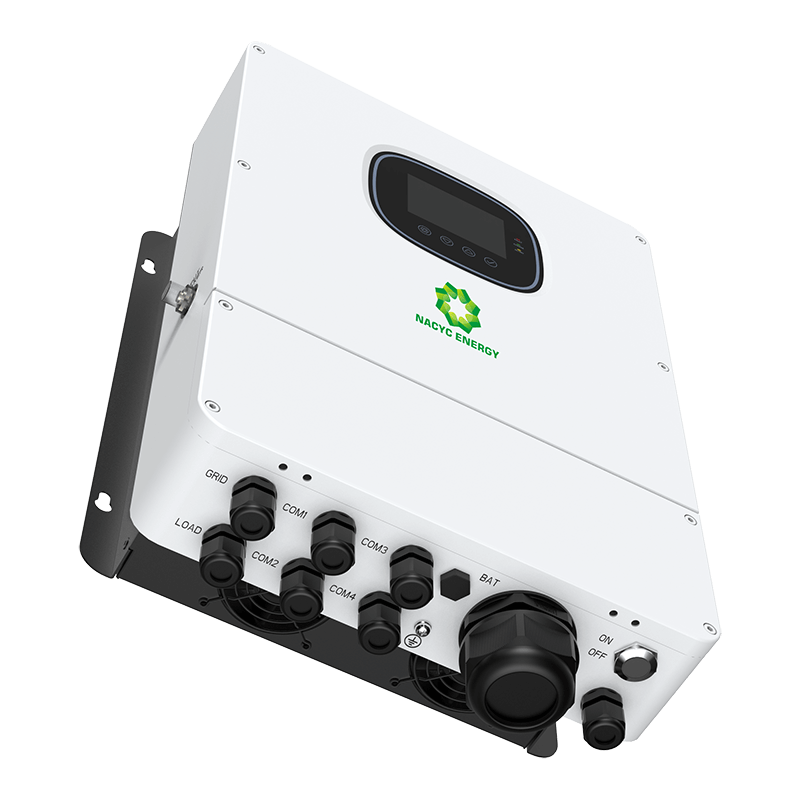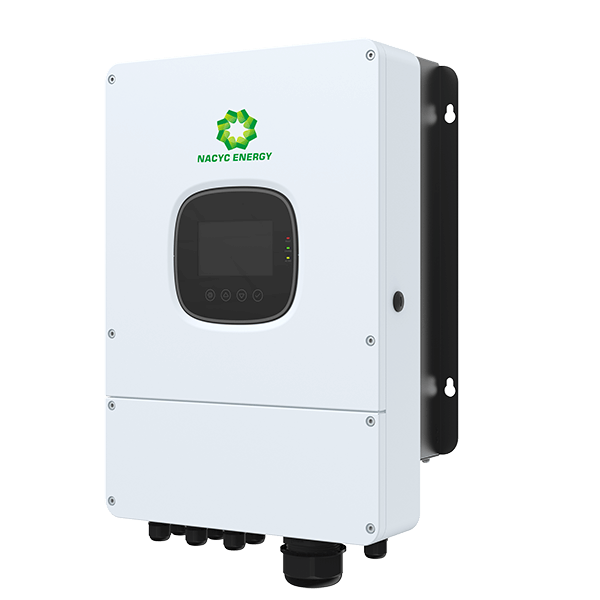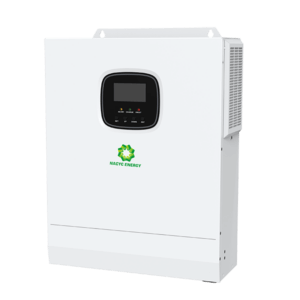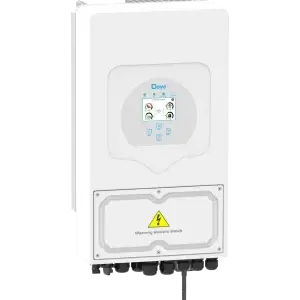6kW Solar Hybrid Inverter
The 6kW Solar Hybrid Inverter, with its IP65 rating, is an epitome of durability and efficiency, designed to meet the demands of both modern homes and businesses. This robust inverter is engineered to withstand challenging environmental conditions, ensuring long-lasting performance and reliability.
A key aspect of this solar storage inverter is its dual Maximum Power Point Tracking (MPPT) system. This technology enables the inverter to maximize the efficiency of solar panels by independently tracking and optimizing the energy from multiple PV arrays. The result is an enhanced overall energy yield, ensuring that users get the most out of their solar investment. This is particularly beneficial in varied or partially shaded environments where solar panel efficiency can fluctuate.
Its grid-feeding capability is a standout feature, allowing users to sell excess energy back to the grid, turning their solar installations into profitable ventures.
Furthermore, the inverter boasts innovative time-slot functionality for battery charging and discharging. This feature allows users to strategically manage their energy storage and usage, taking advantage of lower electricity rates during off-peak hours. By setting specific times for charging the battery from the grid and utilizing stored energy when rates are higher, users can significantly reduce their electricity bills. This level of control and flexibility makes the 6kW Solar Storage Inverter a smart choice for those looking to optimize their energy usage and costs, while contributing to a more sustainable future.
6kW
Power Output
220-230V
Single Phase
2 MPPTs
Best Efficiency
500V
DC Inputs
Dual MPPT System
Features two Maximum Power Point Trackers, optimizing efficiency for each solar panel array, especially in varied lighting conditions.
IP65 Rated Durability
Designed to endure harsh environmental conditions, ensuring long-lasting performance and reliability in outdoor installations.

Uninterrupted Power Supply
Featuring two output modes, mains bypass, and inverter output, the inverter ensures continuous power supply, crucial for reliability and operation in various settings.
Grid-Feeding Capability
Offers the option to sell excess energy back to the grid, transforming solar systems into profitable and sustainable solutions.
| Technical Specifications | |
|---|---|
| Rated Output Power: | 6000W |
| Max.Peak Power: | 12000W |
| Rated Output Voltage: | 230Vac, single-phase |
| Max. Parallels: | 6 PCS |
| Battery Type: | Lead-acid / Li-ion |
| Rated Battery Voltage: | 48V |
| Max. MPPT Charging: | 100A |
| Max. PV Input: | 2 MPPTs, 4500W+4500W |
| Max. DC Input | 500VDC+500VDC |
| MPPT Range: | 120-450VDC |
| Technical Specifications | |
|---|---|
| MPPT Efficiency: | 99.9% |
| Dimensions: | 670*440*240mm |
| Weight: | 37kg |
| Protection Degree: | IP65 |
| Operating Temperature: | -25~60℃ |
| Embedded Interfaces: | RS485 / CAN / USB / Dry contact |
| Communication: | Wi-Fi / GPRS Optional |
| Safety: | IEC62109-1, IEC62109-2 |
| EMC: | EN61000-6-1, EN61000-6-3, FCC 15 class B |
| Warranty: | 5 Years |
Frequently Asked Questions
6kW Solar Hybrid Inverter
This hybrid solar inverter offers versatile charging modes to accommodate various energy needs and scenarios. These modes include:
Solar Power Mode: In this mode, the inverter primarily uses solar energy to charge the battery. It's an eco-friendly option that maximizes the use of renewable energy. Ideal for sunny days when there's ample solar power available.
Mains Power Priority: This mode gives preference to mains (grid) power for charging the battery. It’s useful when solar energy is insufficient, like during cloudy days or at night. The inverter will automatically switch to solar charging when mains power is not available or is more expensive.
Solar Power Priority: Opposite to the mains priority, this mode prioritizes solar power for charging. The inverter will switch to mains power only when the solar energy is not adequate to meet the load demand. It's perfect for locations with high solar energy availability and for reducing reliance on the grid.
Mixed Charging (Solar and Mains Power): This mode combines both solar and mains power for charging. It intelligently balances the use of solar and grid power, ensuring efficient energy usage and constant power supply. Ideal for maintaining a continuous power supply in varying environmental conditions.
Generator Charging: If connected to a diesel generator, the inverter can also use it for charging, especially useful in areas with limited grid access or during prolonged power outages.
The IP65 rating indicates that the inverter is dust-tight and protected against water jets from any direction, ensuring durability and reliability in various environmental conditions.
The dual MPPTs allow the inverter to optimize the efficiency of two separate solar panel arrays, maximizing solar energy harvest and overall system performance.
Time-slot charging and discharging enable users to set specific periods for battery charging and use, optimizing energy costs by utilizing lower electricity rates during off-peak hours.
The dry contact function allows the inverter to control a diesel generator's switch for charging the battery. It automatically activates the generator when the battery voltage is low, ensuring continuous power supply
Parallel working refers to the ability of a solar inverter to work in conjunction with multiple units in parallel. This feature allows for increased power output and system scalability. By adding more inverters in parallel, homeowners can expand their solar system's capacity without compromising efficiency or performance. Parallel working also enhances system reliability, as the load is distributed among multiple inverters, reducing the impact of a single point of failure.
Pros of low-voltage batteries include lower cost, easy maintenance, and better compatibility. They are more affordable, require less effort to maintain, and work well with various systems.
However, there is a drawback. When the accumulative current in the system becomes too large, it can potentially lead to safety and efficiency issues.
But for residential storage systems below 20kWh, low-voltage batteries are a more balanced and economical choice.






